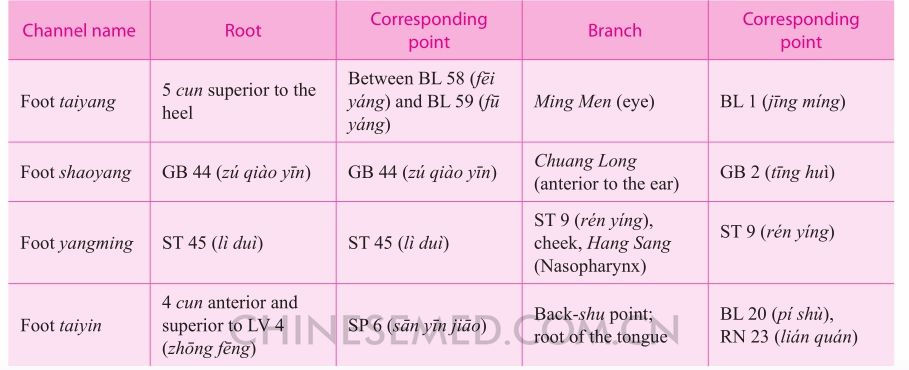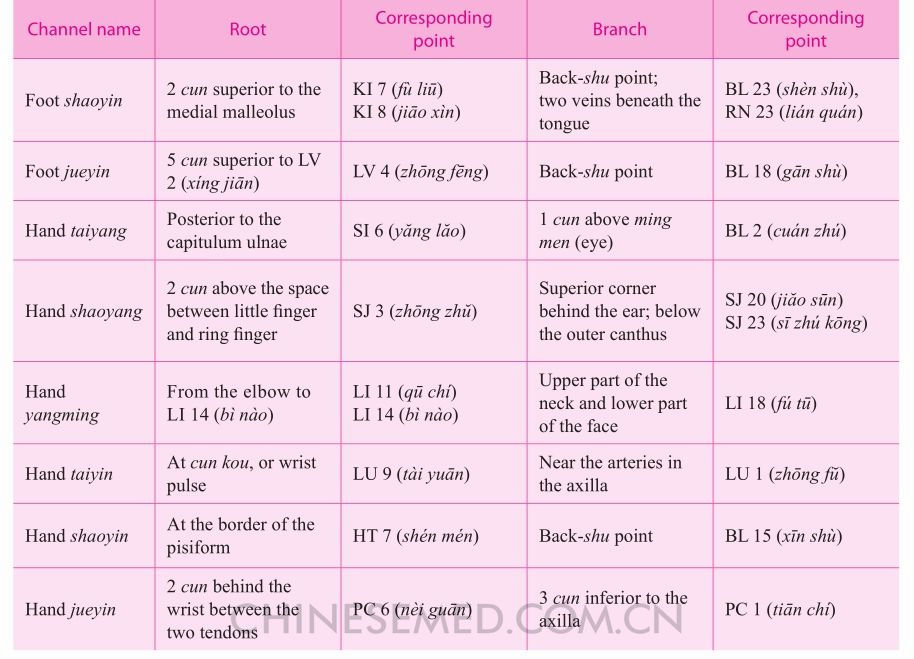The theories of origin and junction, branch and root, qi pathway, and the four seas are the bases for understanding the functions of the different channels and collaterals. They explain the differences and similarities of the channels and collaterals at the limbs, head, chest, and abdomen and provide guidance for clinical pattern differentiation and point selection.
Theory of Origin and Junction
Origin and junction, or ‘gen jie’ (根节) in Chinese, refers to the beginning and end points of the qi of the twelve channels. ‘Gen’, origin, refers to the jing-well points at the extremities. ‘jie’, convergence or junction, refers to the region of the head, chest, or abdomen at which the channel binds. Table 1-3 shows the location of the origin and junction of the six foot channels.
Table 1-3 The location of the origin and junction of the six foot channels

Based on the theory of origin and junction, which holds that channel qi starts from the jing-well points on the extremities, ascends the limbs, and eventually gathers and binds at the abdomen, chest, and head, acupoints on the extremities are important in diagnosing and treating disorders of the trunk and cranium.
Theory of Branch and Root
‘Branch and root’, or ‘biao ben’ (标本) in Chinese, refers to superior and inferior locations on the channels. ‘Ben’ originally meant the root of a plant. In branch and root theory it refers to the four limbs of the body, especially the regions below the elbow and knee joints. The original meaning of ‘biao’ was tree branch. In this case, it refers to the upper part of the body: the head, face, chest, abdomen, and back. The theories ‘branch and root’ and ‘origin and junction’ are similar and deal with primary and secondary relationships among the limbs, trunk, head, and face. They emphasize the importance of the channels at the four limbs. However, ‘origin’ refers to the jing-well points at the extremities, while branch and root specify relative positions; the root is usually located below the elbow or knee; the branch, at the back-shu points of the zang-fu organs. The theories emphasize that points below the elbow and knee have important therapeutic effects on distal areas such as the trunk, head, and face, and they provide a theoretical framework to guide point selection in clinical practice. The Spiritual Pivot-Wei Qi (Líng Shū-Wèi Qì, 灵枢·卫气) gives the locations of the branch and root of each channel (Table 1-4).


Qi Pathways
‘Pathway’ suggests a city street as opposed to an alley. A qi pathway is the route that channel qi commonly travels, where it gathers, and along which it spreads. The human body has four qi pathways, one each in chest, abdomen, head, and leg (Table 1-5).

Qi pathway theory accounts for the horizontal connections among channels through which channel qi is transported and for the anterior and posterior distribution of zang-fu qi. The theory provides theoretical support for point selection in clinical practice.
Theory of the Four Seas
The sea is the gathering place of rivers. Qi and blood travelling inside the channels eventually gather at places in the human body as rivers gather in the sea, thus giving rise to the concept of ‘seas’ in the human body. The Spiritual Pivot-Theory of Seas (Líng Shū-Hăi Lùn, 灵枢·海论) classifies four regions, stomach, chong mai, RN 17 (dàn zhōng), and brain as the four seas: the stomach is the sea of water and grain; chong mai, the sea of blood; RN 17 (dàn zhōng), the sea of qi; the brain, the sea of marrow. The text also notes points at which the four seas transport and infuse (Table 1-6).

The channel and collateral system comprises channels, divergent collaterals, and countless minute and superficial collaterals. The channel qi and blood gather to form ‘seas’ and their routes through the head, chest, abdomen, and leg are the qi pathways. The theories of origin and junction and branch and root, coupled with the theories of the four seas and the qi pathways, elucidate relationships among the parts of the body and help to explain the therapeutic effects of the points.

